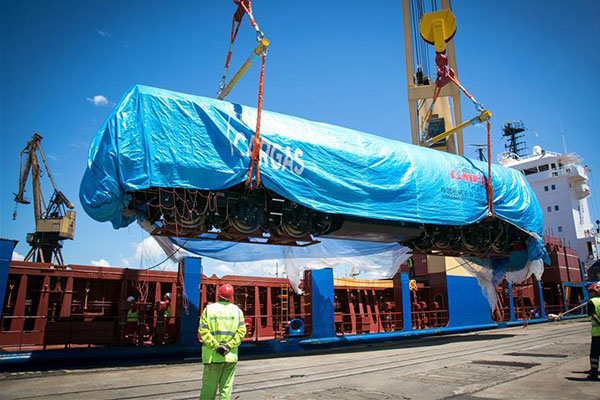
Photo provided by Argentina’s Transport Ministry shows workers unloading one of the two new Chinese-built locomotives for the Belgrano Line, in Buenos Aires, Argentina, on Feb 8, 2017. Two Chinese-built locomotives arrived in Argentina on Feb 8, as part of an ambitious plan to revive the South American country’s aging cargo rail network and spur the country’s economic development. [Photo/Xinhua]
Two Chinese-built locomotives arrived in Argentina on Feb 8, as part of an ambitious plan to revive the South American country’s aging cargo rail network and spur the country’s economic development. The locomotives’ 2,950 horsepower doubles the drive of the current antiquated engines serving the Belgrano Cargas rail line, and can reach a maximum speed of 80 km per hour.
“It has been 40 years since new locomotives were incorporated and these are the first two for the Belgrano line,” Argentina’s Transport Minister Guillermo Dietrich told reporters.
China has been a key partner in helping modernize Argentina’s transportation infrastructure.
It had previously delivered two locomotives for a different rail line, and supplied trains for the urban rail system serving the capital Buenos Aires.
The new locomotives are part of Plan Belgrano, an initiative to promote the development in Argentina’s northern provinces by reviving the cargo rails and facilitating the shipment of goods.
“This is a very important extension, it is the one that is going to make it possible to, among other things, develop northern Argentina, because it connects provinces in the north of the country to the ports of Rosario and Buenos Aires,” said Dietrich.
The locomotives arrived at the port of Buenos Aires aboard the BBC Austria, a vessel sailed from Shanghai, China. They are to be transported to Cordoba, a city in central Argentina, where they will undergo final testing before being placed on tracks.
Argentinean officials from various railroad sectors, including Ezequiel Lemos, president of the State-run firm Argentinean Cargo Trains, were on site to receive the locomotives.
Lemos underscored the importance of renovating the system.
“Each new locomotive that arrives is essential to the transformation of Argentina’s rail network. We consider that these are coming to bolster the fleet that replaced the steam engines,” added Lemos.
He said the Chinese locomotives will “help to reduce transport times, increase the reliability of the service, and as a result benefit regional producers and economies, which have lost the most after the cargo train stopped running.”
Dietrich highlighted the need to have all the transportation options available to improve the country’s export capacity.
In addition to modernizing its cargo trains, with China’s help, Argentina has been taking other steps, such as improving access to ports and lowering the costs of shipping “to boost our country’s competitiveness and production, and to create more jobs,” said Dietrich.
The locomotives are part of a comprehensive overhaul of the rail system, largely financed by an agreement with the China Machinery Engineering Corporation.
The purchase included 3,500 wagons, 2,530 of which have already been delivered, and another 107 locomotives, plus spare parts, machinery, tools and shipping containers.
With the cooperation with China, Argentina will also see 1,600 km of the Belgrano Cargas tracks renovated across six provinces. The first 500 km have already been up and running.
